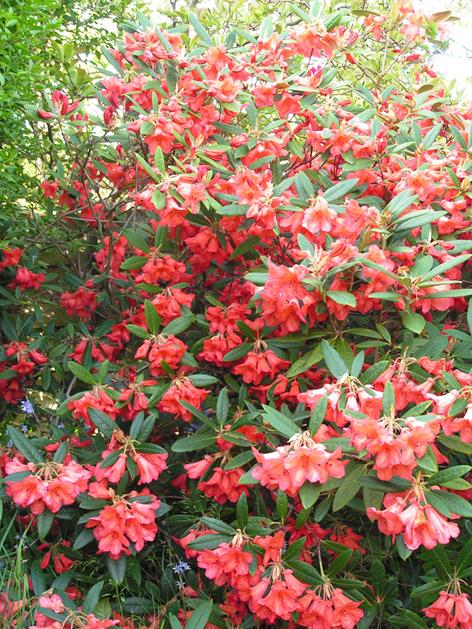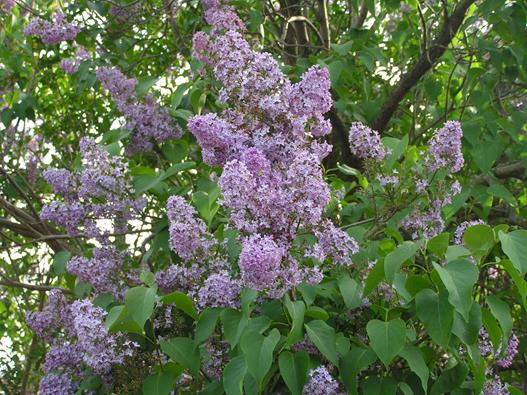A few years ago here in Britain we were told have every year the flowers were blooming earlier and earlier because of global warming. One of the most beautiful natural woodland signs of spring is a carpet of bluebells in April time. Well this morning I took a walk in Workington in the far north of England and the bluebells were in full bloom. Mixed with the smell of wild garlic it was a wonderful experience. Here in Manchester, the bluebells in my garden – in the most informal, organic and highly naturalistic sense of the term – are still in bloom about a month later than normal. By now I have had to lop the dead heads and pull up the long leaves before they rot, becoming food for the slugs that plague the garden. The rhododendron is blooming at least a week late. They normally are in bloom for two weeks in late May. By 1st June, the flowers are past their best. I also include a picture of the lilac tree, obtained with the house and occasionally pruned in a most irregular fashion.
The rhododendron was purchased from Bodnant Garden in North Wales over 20 years ago. Despite my near total inattention, it seems to grow a little each year. This coincided with the period when I ceased being a volunteer rhodie-basher with the National Trust. In many parts of Britain the common purple-flowering ponticum has spread through many areas with peat soils, becoming an invasive species. The bushes grow to over ten metres high, and completely cover the ground, to the exclusion of other plants, including re-generating trees in woodland areas. The waxy evergreen leaves are also acidic, so once cleared the soil can be poisoned for years after. I describe myself as a “slightly” manic beancounter. There was nothing slight about the manic ferocity that I used to hack the invaders down with a bow saw, smash and tear up the roots with a mattock and then consign the whole lot with to a flaming pyre.
The bluebell seeds were given to me by the late Joyce and Jack Page, a keen pair of organic gardeners. I was warned that they could spread, so ignored their advice and scattered them in various patches in the both front and back. Now, every other year I dig out all the bulbs I can find, but they keep re-sprouting.




Brian H
/ 02/06/2013Deadly battles …
tckev
/ 02/06/2013Hopefully the early bumble bees have got the nectar from both the bluebells and the lilac. These small blue flower usually attract them.
Mike Jowsey
/ 02/06/2013Of course, it’s only weather! Albeit weather at total odds with GCMs (general circulation models) for the sixth year running.
Mike Jowsey
/ 02/06/2013Another point, implied by your article MBC, is that if this was the sixth year running of earlier springs, would the MSM (main stream media) be following it? Nay, headlining with it!
manicbeancounter
/ 02/06/2013You are quite right. A few years ago there was lots of signals of global warming in Britain like
– Flowers blooming earlier.
– Grapes being grown ever further North. I am a few miles North of the “grape line”, but over 100 miles south of Hadrian’s Wall where the Romans grew their grapes.
– Migrating birds arriving earlier and leaving later.
There must be a great deal of data on all of this. What has happened to these studies?
honestcal
/ 04/06/2013Reblogged this on Sunrise's Swansong and commented:
I find it interesting that April Bluebells are blooming in June, over in England.
Caleb Shaw
/ 04/06/2013“honestcal” is me. I like your site.
Back in 1970-1971 I attended a school way up in northern Scotland, located at Dunrobin Castle. The rhododendrons on the grounds were tall and vigorous, but around this time of year we schoolboys were going a bit crazy, studying for our O-levels and A-levels, and to blow off steam we developed a sport we called “rhododendron swimming.”
What we would do is climb a low tree and then launch out into the rhododendrons, with our arms spread wide, gathering enough of the slender shoots in our arms to create a sort of springy surface, between eight and ten feet off the ground. Then, by sweeping inward with your arms, you could gather more of the topmost shoots in front of you, and squirm forward. In this manner you could make slow progress across the roof of the vast patch. It was really lovely, with all the blooms bobbing about you, but if you were not careful you might fall through, and descend to the earth with a great deal of snapping and cracking and crunching. All the other boys would laugh, and say you had “drowned.”
Of course this was rough on the plants, and we had to move onward, deeper and deeper in the patch, leaving the rhododendrons behind rather the worse for wear. We were careful to never crush the plants at the edge of the road, where the gardener could see, but just in from the road and the paths it eventually looked like a war zone, and we had to find a different sport.
For over 40 years I have felt guilty about what I did to the Countess of Sutherland’s rhododendrons. I can’t tell you how glad I am to hear they are a invasive species, and deserve to be crushed. And all this time I thought I, as a rowdy American, was the invasive species!
I only spent a single year “across the pond,” but I’ll never forget how wonderful the long, light-filled days of late spring and summer were, after the awfully short, dark days of Scotland’s winter.
manicbeancounter
/ 04/06/2013I hope it the was the purple-headed ponticum variety that you were destroying. They grow quickly on peaty soils in damp conditions. The other varieties can take a long time to grow. However, they do grow back.
I never realised the grand Dunrobin Castle had a school. I have only once visited this almost fairy-tale like building, but have passed on a number of times on the way North to my mother’s home-town of Wick. It was a big surprise when I first visited my future in-laws in Southern Brazil that they has a picture of the castle on the wall.
http://www.dunrobincastle.co.uk/